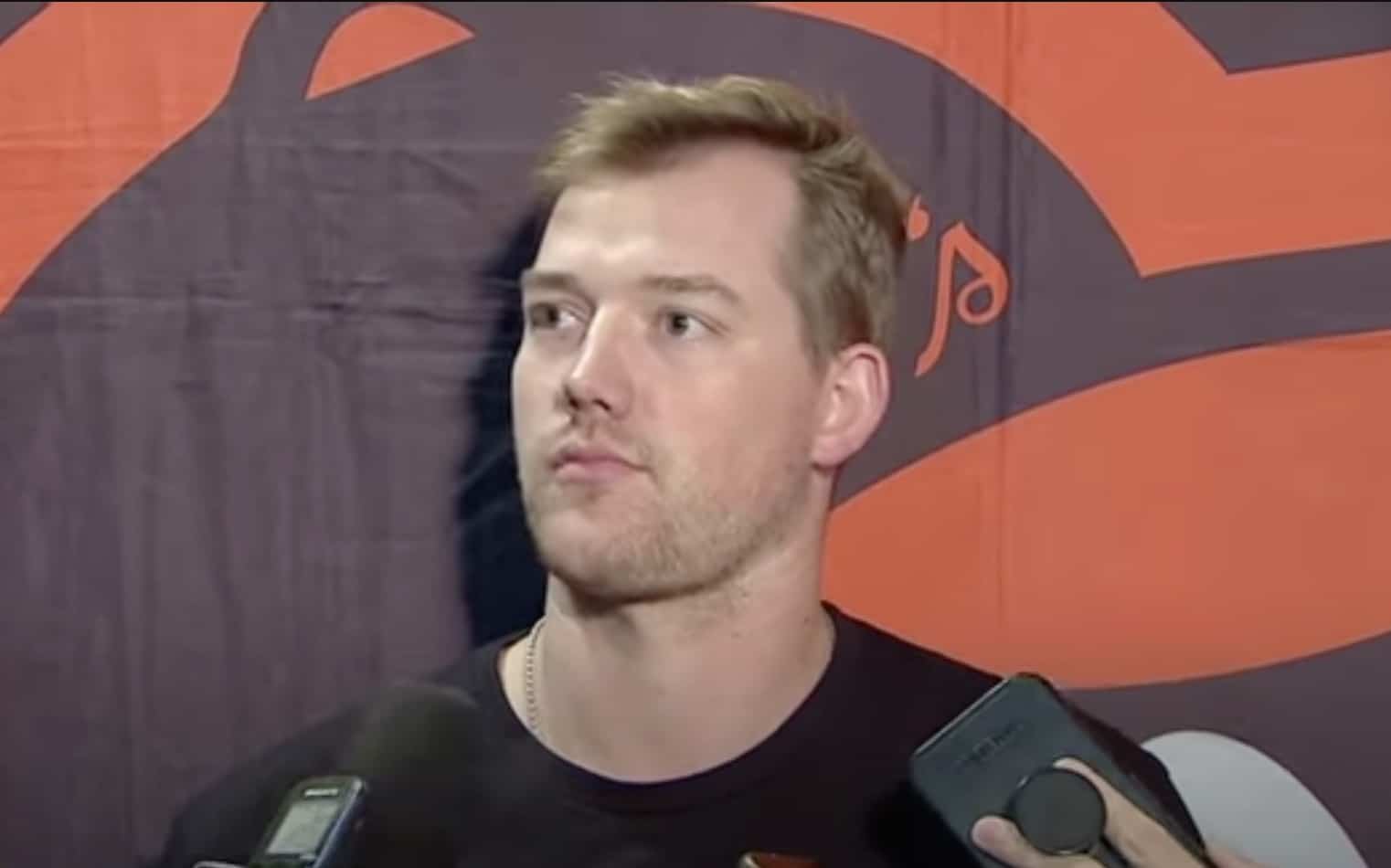No team scored as many points as the Baltimore Ravens over the last two regular seasons.
They rushed for an NFL-record 6,367 yards over these last two years, a total exceeding that of the Pittsburgh Steelers over their last four campaigns combined (5,910 yards). And despite registering a league-low 846 pass attempts over the last two seasons, Baltimore still threw eight more touchdowns than the Atlanta Falcons, who had an NFL-high 1,312 passing attempts over that stretch.
And some are calling for offensive coordinator Greg Roman to be fired?
You can understand head coach John Harbaugh being a little defensive in response to criticism of Roman, star quarterback Lamar Jackson, and a passing game that indeed took a step back in 2020.
“It goes back to the same criticisms that we’ve heard for the last three years about not being the type of an offense or the type of a quarterback that some people want to see,” Harbaugh said in his season-ending video call with the media on Wednesday. “They’re just going to have to live with it because Lamar Jackson has won a lot of football games here. Our offense has won us a lot of football games here, and we’re not apologizing for that for one second. We are going to improve it, no question about it. We’re going to go to work to be more precise, more efficient, [and] better at what we do. That’s what we have to do — be better at it.”
Of course, those shiny numbers have vanished in the postseason as the Ravens scored a 2019-low 12 points in last year’s January loss to Tennessee and a season-low three in Saturday’s divisional-round defeat at Buffalo — two opponents who hardly sported elite defenses. As Harbaugh said himself, even the best teams are “really a failure” until winning a Super Bowl in this results-driven business. The Ravens must find a way to improve throwing the ball when inevitably forced to do so at some point in January because it’s very difficult imagining this ground attack getting much better than it’s already been these last two years.
They need that Plan B.
Harbaugh is correct about some of the criticism for the passing game, beginning with that popular citing of passing yards per game as the be-all and end-all when it’s not a particularly useful gauge for any offense. Yes, the Ravens ranked 32nd in passing yards in 2020, but this was never designed to be a high-volume attack, nor should it be with a historic running game and the greatest rushing quarterback in NFL history. For perspective, the 2019 team ranked only 27th in passing yards per game while still managing to lead the league in touchdown passes and finishing a rock-solid 12th in yards per pass attempt (7.6). In contrast, the 2015 Ravens ranked eighth in the league in passing yards per game, but no one would argue that was anything but a bad offense in a lost season.
Any fair criticism isn’t really calling for the Ravens to throw the ball more frequently as much as for their need to be more effective when doing it. Jackson’s yards per attempt fell from 7.8 to 7.3 and his completion percentage dropped from 66.1 percent to 64.4 percent this season. After finishing first in Football Outsiders’ DVOA passing efficiency metric in 2019 — a number Harbaugh even cited during his Wednesday video call — the Ravens fell to 17th this year, and that was after a late-season bump.
Those calling for Roman to be replaced should carefully take note of what happened to the Ravens’ stout running game when transitioning from Gary Kubiak in 2014 to Marc Trestman in 2015. As intriguing as it might be to ponder Jackson the passer with a different coordinator, walking away from a record-setting running game that largely contributed to 26 wins in two seasons just isn’t the kind of move a strong organization makes without exhausting other avenues to improve.
Tweaks and adjustments are certainly in order, however, ranging from improving the pass protection to the play calling.
It’s interesting to note Jackson’s best passing numbers came on first down this season despite the Ravens throwing less frequently than all but one team on that down. They also had a better success rate throwing the ball (54 percent) than running it (51 percent) on first-down plays, according to SharpFootballStats.com. Mixing in a few more passes in early-down situations when opponents are expecting the run is not only supported by Baltimore’s own numbers, but that principle is backed up by football analytics when discussing the most efficient way to call plays. Those first-down passes can lead to more short-yardage situations to run on second and third down to move the chains and avoid second- or third-and-long plays where the defense knows you’re passing.
Other possible changes are more complicated with some analysts and former players questioning the overall sophistication of Roman’s passing game and its impact on Jackson’s development. Harbaugh bristled at recent assessments from Hall of Fame quarterback Kurt Warner and former Baltimore wide receiver Steve Smith, maintaining the Ravens have the most effective movement and play-action passes in the league while acknowledging they’re not going to be as complex as a team throwing the ball “40 to 50 times a game” like the Steelers.
“Does the system allow [Jackson] to probably thrive? No, but what is the constraint?” said former NFL quarterback and The QB School’s J.T. O’Sullivan in an extensive video review (see below) of Jackson and the passing game in the playoff loss. “Are they not pushing the envelope because they don’t have the capacity as an offensive unit, as a perimeter skill group, as decision-making [goes] from within the pocket? Or, are they just letting him down? Should it be more? Should he be able to do more?
“I can see why maybe they are self-containing themselves with only a certain number of dropback plays because there are times when there are things open down the field and, for whatever reason, the ball isn’t delivered. And then there are times when they run the same play a few times, and it’s not that great of a play or there’s communication errors as far as where maybe someone was open the previous time they ran the play. Just getting all those things aligned, to me, there are just some missing parts.”
The biggest perceived missing part to many is an established high-end wide receiver to serve as Jackson’s go-to weapon and divert some of the attention from 2019 Pro Bowl tight end Mark Andrews and speedy wideout Marquise Brown, who combined to account for 48 percent of Baltimore’s targets this season. But given the anticipated 2021 salary cap constraints created by the COVID-19 pandemic and the business-minded reality of a wide receiver playing in such a run-heavy offense, how easily can general manager Eric DeCosta bring in this team’s version of an Anquan Boldin, who was so important to Joe Flacco’s development into a Super Bowl-winning quarterback?
Harbaugh says he isn’t going to “beg” a wide receiver to sign with Baltimore if the allure of winning doesn’t exceed “your stat line and how many balls you catch.” Of course, money will also be a determining factor.
“Can we afford it, and what are the resources from other things that we need? That’s the details that we have to figure out,” Harbaugh said. “But I think a big, physical receiver would be awesome for us and a big target for Lamar. It could be another tight end too. A speed guy that can open things up and open the coverage up would be valuable too.”
Of course, none of these factors ultimately carry as much weight as Jackson himself, who experienced some inevitable statistical regression this season after he threw a touchdown on a league-high nine percent of his pass attempts in 2019. The offensive failures were a team effort on Saturday, but there were many plays — complete with open receivers and adequate protection — left on the field long before Jackson’s interception returned 101 yards for a touchdown to put the game out of reach.
The 24-year-old’s improvement will be the biggest variable in determining whether the Ravens can succeed on those occasions when an opponent manages to contain their ground game, especially in January. The efficiency Jackson displayed as a league MVP at age 22 provides plenty of reason to be optimistic about improving this passing game while the offense continues to reap the rewards of such a gifted athlete anchoring a record-setting rushing attack. Make no mistake, most NFL teams would kill to have that kind of floor while trying to improve their passing game with a young quarterback who still posted a 99.3 passer rating in 2020.
But Jackson and the Ravens have to go to work to be ready for that next opportunity in the postseason. The last three Januaries have proven the overwhelming need for a Plan B.
“I just think he’ll look back at the whole season — not just this game, the whole season — and he’ll make those adjustments that he needs to do to be an elite quarterback — an even more elite quarterback,” said veteran receiver Willie Snead, who played three seasons with future Hall of Famer Drew Brees in New Orleans. “He’s an elite runner, an elite passer, but there are steps he can take, better strides that he can take, and he knows that. That’s the competitor in him to want to get better each and every offseason to fix the little things that his game needs improvement on and continue to get better as a passer.
“I think if he knuckles down on that part of his game and really reaches his full potential in that area, then the sky is the limit for Lamar. It’s just a matter of time, so it’s really on him. I think this game is going to be a wake-up call for him, hopefully this offseason. We’ll see what he does next year.”

































